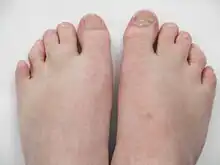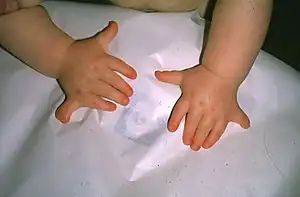Dysmelia
Dysmelia (from the Greek dys (δυσ-), "bad" + mélos (μέλος), "limb" + English suffix -ia) is a congenital disorder of a limb resulting from a disturbance in embryonic development.[1]

Types

Syndactyly of the second and third toes
Dysmelia can refer to
- missing (aplasia) limbs: amelia, oligodactyly, congenital amputation e.g. tibial or radial aplasia
- malformation of limbs: shortening (micromelia, rhizomelia or mesomelia), ectrodactyly, phocomelia, meromelia, syndactyly, brachydactyly, club foot
- extra limbs: polymelia, polydactyly, polysyndactyly
- others: tetraamelia, hemimelia, symbrachydactyly

Bilateral polydactyly with short fingers in Ellis–Van Creveld syndrome patient
Occurrence rate
Birth defects involving limbs occur in 1 per 1000.
Causes
Dysmelia can be caused by
- Inheritance of abnormal genes, e.g. polydactyly, ectrodactyly or brachydactyly, symptoms of deformed limbs then often occur in combination with other symptoms (syndromes)
- external causes during pregnancy (thus not inherited), e.g. via amniotic band syndrome
- teratogenic drugs (e.g. thalidomide, which causes phocomelia) or environmental chemicals
- ionizing radiation (nuclear weapons, radioiodine, radiation therapy)
- infections
- metabolic imbalance
Syndromes with dysmelia
- 2p15-16.1 microdeletion syndrome
- Achard syndrome
- Ackerman syndrome
- Acrocallosal syndrome
- Acropectoral syndrome
- Adams–Oliver syndrome
- Aglossia adactylia
- Amniotic band syndrome
- Apert syndrome
- Autosomal recessive Robinow syndrome
- Basel–Vanagaite–Sirota syndrome (Microlissencephaly-Micromelia syndrome)
- Campomelic dysplasia
- Cardiofaciocutaneous syndrome
- Catel–Manzke syndrome
- Cenani–Lenz syndrome
- Corneodermatoosseous syndrome
- Diploid triploid mosaic
- Ectrodactyly–ectodermal dysplasia–cleft syndrome
- Edwards syndrome
- Ellis–Van Creveld syndrome
- Fibular dimelia diplopodia syndrome (Leg duplication mirror foot syndrome)
- Greig cephalopolysyndactyly syndrome
- Haas syndrome
- Hanhart syndrome
- Holt–Oram syndrome
- Humeroradial synostosis
- Johnson–Munson syndrome
- Joubert syndrome
- McKusick–Kaufman syndrome
- Mermaid syndrome
- Mesomelia-Synostoses syndrome (8q13 microdeletion syndrome)
- Microgastria
- Myhre syndrome
- Nager acrofacial dysostosis
- Neu–Laxova syndrome
- Patau syndrome
- Pfeiffer syndrome
- Poland syndrome
- Radial aplasia
- Roberts SC-Phocomelia syndrome (Phocomelia syndrome)
- Rubinstein–Taybi syndrome
- Silver–Russell syndrome
- Split-hand split-foot malformation (SHFM)
- TAR syndrome (thrombocytopenia with absent radius)
- Tetra-amelia syndrome
- Ulbright–Hodes syndrome
- VACTERL association
- Wallis–Zieff–Goldblatt syndrome
References
- (2006) Dysmelia (Limb Deficiency/Reduction). pp 312-322. In: Atlas of Genetic Diagnosis and Counseling. Humana Press.
External links
This article is issued from Wikipedia. The text is licensed under Creative Commons - Attribution - Sharealike. Additional terms may apply for the media files.